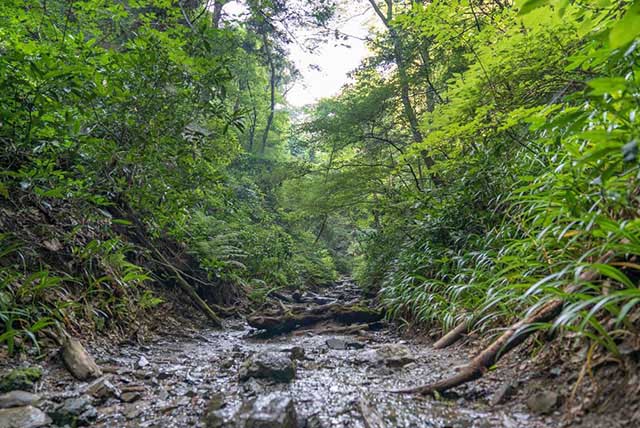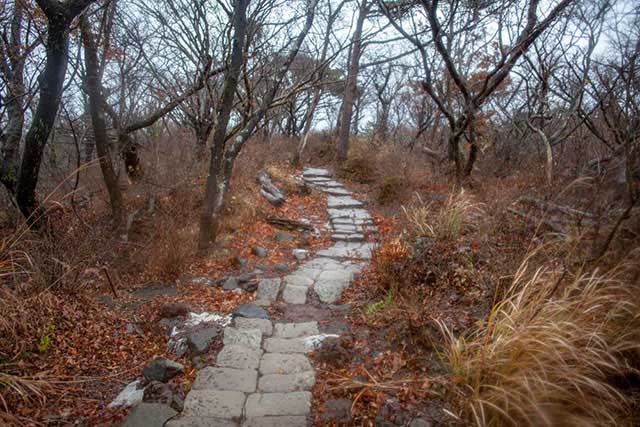
While the renowned Japanese seafood draws visitors out to the archipelago’s coastlines, the country’s infinite mountains are sure to drag keen hikers back inland. Almost three quarters of Japan is made up of mountains which pepper the country from top to bottom. From the largest collection of mountain ranges, known as the Japanese Alps, in the centre of the country to the highest and most iconic of the country’s peaks, Mt. Fuji, Japan offers endless opportunities of varying difficulty to get up high and enjoy the views.
-
01
Easy hike: Mt. Takao
![Easy hike: Mt. Takao]()
Easy hike: Mt. Takao
A jaunt up Mt. Takao is an easy day trip from Tokyo with Takaosanguchi Station, the easiest access point, just 50 minutes from Shinjuku on the Keio Line. The mountain offers a relatively easy climb of around one to two hours through woodland, so, before setting off, be sure to pick up a map from the information centre to decide on some of the numbered routes, most of which are well paved and signposted.
![Easy hike: Mt. Takao]()
Easy hike: Mt. Takao
Best known as a way to escape the heat in the middle of July and August, and for the vibrant autumn leaves in October and November, these are the most popular months of the year to visit; however, the mountain’s proximity to Tokyo means that crowds of walkers visiting at this time of year can spoil the views. If you plan to visit in summer or autumn, head out to Takao on a weekday, early in the morning. While it’s never a mistake to stock up on snacks and drinks before a walk, the walking paths around the top of the mountain are padded with food stalls and vending machines, so there are plenty of opportunities to fill up along the way.
-
02
Intermediate hike: Kirishima Kinkowan National Park
![Intermediate hike: Kirishima Kinkowan National Park]()
Intermediate hike: Kirishima Kinkowan National Park
Straddling the prefectures of Miyazaki and Kagoshima, the expansive Kirishima Kinkowan National Park comprises an impressive 23 volcanoes, many of which are still active. While the park stretches down to the most southern peninsula of the Japanese mainland, Satsuma Peninsula, the best climbing is found around Mt. Kirishima in the north of Kagoshima Prefecture.
![Intermediate hike: Kirishima Kinkowan National Park]()
Intermediate hike: Kirishima Kinkowan National Park
For a hike of around six hours, the Kirishima Ridge Trail is a 12-kilometer route that runs from Ebino Kogen to the Takachiho-gawara Visitor Center, boasting incredible landscapes including volcanic lakes and nearby natural hot springs. A more leisurely but equally impressive route is up Mt. Karakuni, the tallest of the national park’s peaks.
![Intermediate hike: Kirishima Kinkowan National Park]()
Intermediate hike: Kirishima Kinkowan National Park
Starting at the Onami-no-ike Tozanguchi, which can be reached by bus from Kirishima Jingu Station, a two- to three-hour hike will take you to the summit, which overlooks the picturesque Takachiho-no-Mine and Sakurajima. This is recommended as an intermediate challenge in the colder months, when the Kirishima Ridge Trail becomes less accessible.
-
03
Difficult hike: Mt. Fuji Sea to Summit
![Difficult hike: Mt. Fuji Sea to Summit]()
Difficult hike: Mt. Fuji Sea to Summit
There are few mountaineering enthusiasts who would turn down the chance to hike to the summit of Mt. Fuji, 3,776 metres above sea level. The view from the top—admittedly, weather permitting—is as unique and diverse as you could ask for. Fitness levels aside, the main limitation to ascending the mountain is the time of year, as the paths are open to hikers only from the beginning of July to the beginning of September.
![Difficult hike: Mt. Fuji Sea to Summit]()
Difficult hike: Mt. Fuji Sea to Summit
If you’re looking for a real challenge, skip the most common climbs, which start at Mt. Fuji’s fifth and sixth stations. Instead, head for the sea to experience the full ascent—officially named the Mount Fuji Tourism Climbing Route 3,776—which takes you from sea level to 3,776m and covers 42km of ground.
![Difficult hike: Mt. Fuji Sea to Summit]()
Difficult hike: Mt. Fuji Sea to Summit
A downloadable map of the route, with additional activities available along the way and advice on where to stay overnight, is available online. It offers four separate hikes, which Mount Fuji Tourism suggest you do over four days, although they could be done in less.
-
Mt. Fuji Pass
¥5,500
Update date:2024/04/27









 Go here
Go here







